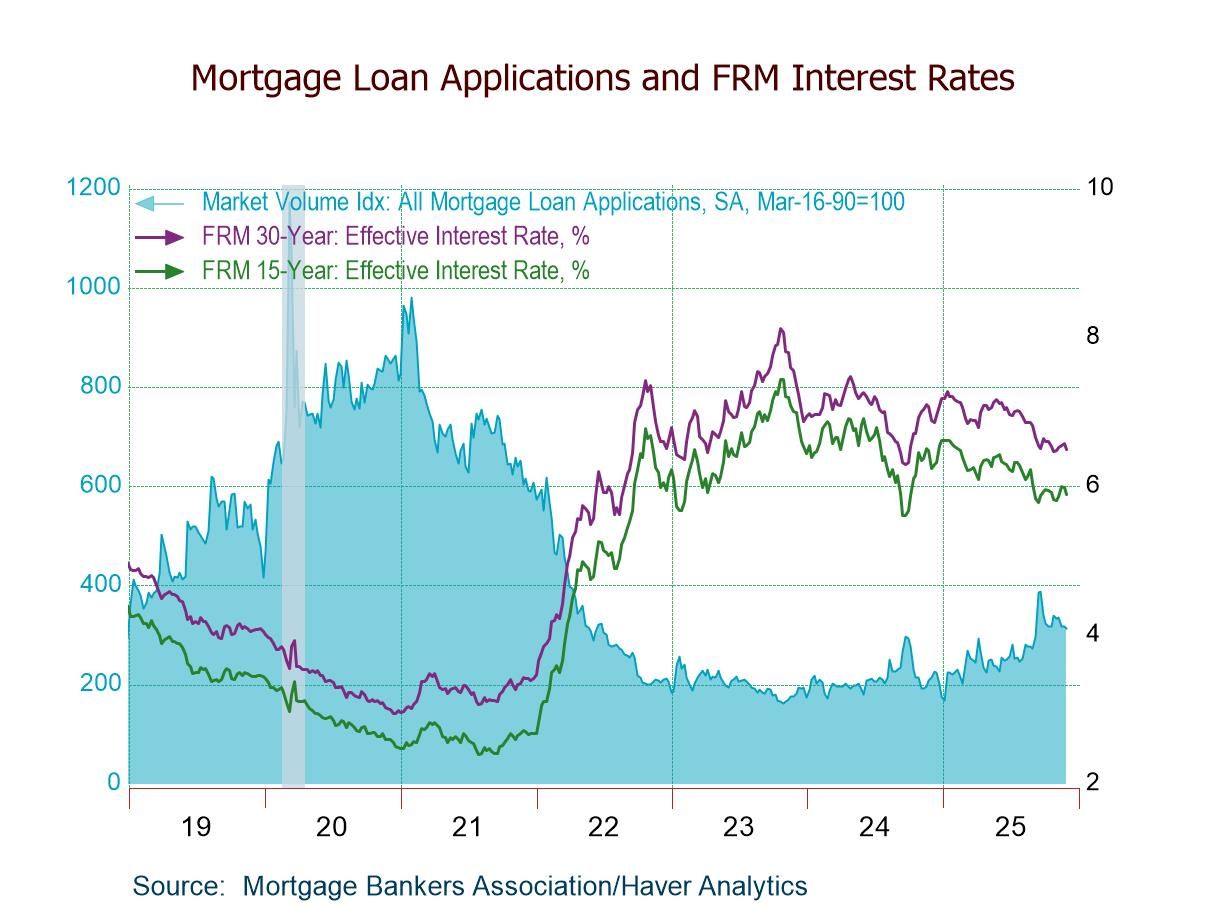 Global| Jan 07 2010
Global| Jan 07 2010U.S. Initial Jobless InsuranceClaims Nudge Higher
by:Tom Moeller
|in:Economy in Brief
Summary
By the smallest of margins, the job market deteriorated last week but the trend continued its recent improvement. The Labor Department reported that initial claims for jobless insurance ticked up 1,000 to open the New Year at 434,000. [...]
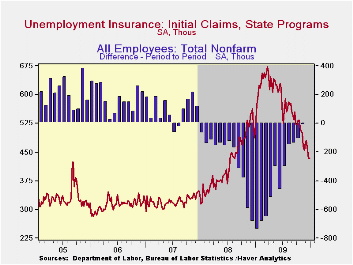 By the
smallest of margins, the job market deteriorated last week but the
trend continued its recent improvement. The Labor Department reported
that initial claims for jobless insurance ticked up 1,000 to open the
New Year at 434,000. Claims stand at the lowest level since late in
August, 2008 and were down from the recession peak of 674,000 hit last
March. Consensus expectations has been for 440,000. The four-week
moving average of initial claims also fell to a new cycle-low of
450,250.
By the
smallest of margins, the job market deteriorated last week but the
trend continued its recent improvement. The Labor Department reported
that initial claims for jobless insurance ticked up 1,000 to open the
New Year at 434,000. Claims stand at the lowest level since late in
August, 2008 and were down from the recession peak of 674,000 hit last
March. Consensus expectations has been for 440,000. The four-week
moving average of initial claims also fell to a new cycle-low of
450,250.
Continuing claims for unemployment insurance during the latest week again fell sharply. The 179,000 drop was part of a nearly one-third decline since late-June. Continuing claims were at the lowest level since January of last year. The overall decline is a function of the improved job market but also reflects the exhaustion of 26 weeks of unemployment benefits. Continuing claims provide an indication of workers' ability to find employment. The four-week average of continuing claims fell to 5,005,750. This series dates back to 1966.
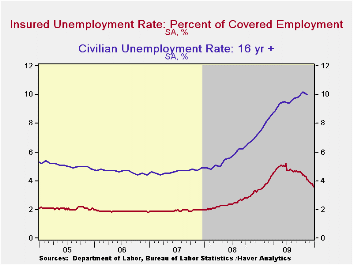 Extended
benefits for unemployment insurance
dropped sharply to 296,534 during the third week of December. The
latest was down by one-half from the peak reached during
November of 597,688.
Extended
benefits for unemployment insurance
dropped sharply to 296,534 during the third week of December. The
latest was down by one-half from the peak reached during
November of 597,688.
The insured rate of unemployment also fell to a new low of 3.6%. The rate reached a high of 5.2% during late-June. During the last ten years, there has been a 93% correlation between the level of the insured unemployment rate and the overall rate of unemployment published by the Bureau of Labor Statistics.
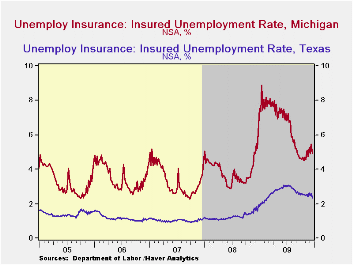 The
highest insured
unemployment rates in the week ending December 19
were in Alaska (6.7 percent), Oregon (5.9), Puerto Rico (5.8), Nevada
(5.6), Idaho (5.5), Pennsylvania (5.2), Wisconsin (5.2), Montana (5.1),
Washington (5.1), and Michigan (5.0). The lowest insured unemployment
rates were in Virginia (2.0), North Dakota (2.2%), Texas (2.4), Florida
(3.1), Wyoming (3.3), Maryland (3.4), Ohio (3.4), Maine (3.5), New York
(3.6) and Mississippi (3.7). These data are not seasonally adjusted but
the overall insured unemployment rate is.
The
highest insured
unemployment rates in the week ending December 19
were in Alaska (6.7 percent), Oregon (5.9), Puerto Rico (5.8), Nevada
(5.6), Idaho (5.5), Pennsylvania (5.2), Wisconsin (5.2), Montana (5.1),
Washington (5.1), and Michigan (5.0). The lowest insured unemployment
rates were in Virginia (2.0), North Dakota (2.2%), Texas (2.4), Florida
(3.1), Wyoming (3.3), Maryland (3.4), Ohio (3.4), Maine (3.5), New York
(3.6) and Mississippi (3.7). These data are not seasonally adjusted but
the overall insured unemployment rate is.
The unemployment insurance claims data is available in Haver's WEEKLY database and the state data is in the REGIONW database.
The minutes to the latest meeting of the Federal Open Market Committee can be found here.
| Unemployment Insurance (000s) | 1/1/10 | 12/25/09 | 12/18/09 | Y/Y | 2009 | 2008 | 2007 |
|---|---|---|---|---|---|---|---|
| Initial Claims | 434 | 433 | 454 | -11.1% | 573 | 419 | 321 |
| Continuing Claims | -- | 4,802 | 4,981 | 6.0% | 5,835 | 3,345 | 2,552 |
| Insured Unemployment Rate (%) | -- | 3.6 | 3.8 | 3.5 (1/2009) | 4.4 | 2.5 | 1.9 |
by Robert Brusca January 7, 2010
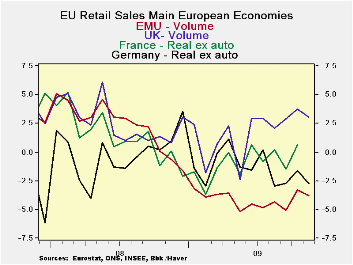
While governments around the world have taken strides to pump up expenditures to keep economies going the consumer, largely, is still not on board, at least not in Europe.
Total Euro-Area consumer spending is down by 0.3% in November after being down in earlier months…seventeen down months in a row in fact. Over three months the pace of contraction in Euro-consumer spending remains about the same as over six months and only a bit less than over 12-months.
Even motor vehicle registrations that had bumped up on special government assistance plans across the various Zone countries fell in off in November. German retailers continue to be hard-hit and to look for a return of the consumer there.
Overnight Australia reported a 1.4% kick to November sales, one of the few places besides the US where the consumer seems to be aware that he has a wallet in his pocket or a purse over the shoulder.
Sustained recovery will require a return of the consumer. Even in Europe the consumer is large proportion of GDP. Right now Europe continues to benefit from export led growth; China pushes export led growth; Japan pushes export-led growth. But for all that to work, the European consumer, and Japanese consumer will have join in. The consumer in the US appears to be back in gear but there is not enough there to feed the global economy with US retail demand. The world economy needs balance. Other countries must get their consumers in gear because ‘everyone wants’ to sell to the US but ‘everyone also wants’ the US trade deficit to shrink and these two ‘everyone wants’ are in deep conflict with each other. So if ‘anyone wants’ logic and consistency something will have to change.
| Euro-Area Retail Sales | |||||
|---|---|---|---|---|---|
| M/M | Saar | ||||
| Oct-09 | Sep-09 | 3-Mo | 6-MO | 12-Mo | |
| Zone Total Value | -0.2% | -0.2% | -2.6% | -2.4% | -3.9% |
| Food,Bev Tobacco | -0.1% | -0.2% | -1.8% | -2.1% | -2.1% |
| Registrations: | |||||
| Motor Vehicle Reg | 0.3% | 6.7% | 9.6% | 3.5% | 26.9% |
| NonFood Country detail: Volume | |||||
| Germany Value | 0.0% | 0.6% | -2.1% | -3.6% | -2.7% |
| UK(EU) Volume | 0.6% | 0.4% | 2.9% | 5.3% | 3.1% |
Tom Moeller
AuthorMore in Author Profile »Prior to joining Haver Analytics in 2000, Mr. Moeller worked as the Economist at Chancellor Capital Management from 1985 to 1999. There, he developed comprehensive economic forecasts and interpreted economic data for equity and fixed income portfolio managers. Also at Chancellor, Mr. Moeller worked as an equity analyst and was responsible for researching and rating companies in the economically sensitive automobile and housing industries for investment in Chancellor’s equity portfolio. Prior to joining Chancellor, Mr. Moeller was an Economist at Citibank from 1979 to 1984. He also analyzed pricing behavior in the metals industry for the Council on Wage and Price Stability in Washington, D.C. In 1999, Mr. Moeller received the award for most accurate forecast from the Forecasters' Club of New York. From 1990 to 1992 he was President of the New York Association for Business Economists. Mr. Moeller earned an M.B.A. in Finance from Fordham University, where he graduated in 1987. He holds a Bachelor of Arts in Economics from George Washington University.





